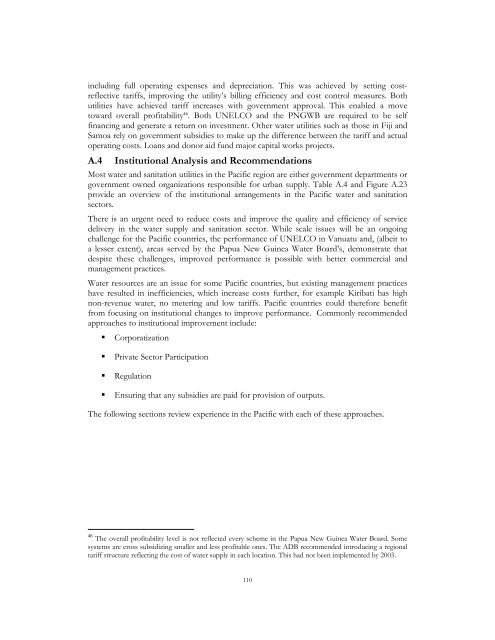EAP - The Pacific Infrastructure Challenge - World Bank (2006).pdf
EAP - The Pacific Infrastructure Challenge - World Bank (2006).pdf
EAP - The Pacific Infrastructure Challenge - World Bank (2006).pdf
You also want an ePaper? Increase the reach of your titles
YUMPU automatically turns print PDFs into web optimized ePapers that Google loves.
including full operating expenses and depreciation. This was achieved by setting costreflective<br />
tariffs, improving the utility’s billing efficiency and cost control measures. Both<br />
utilities have achieved tariff increases with government approval. This enabled a move<br />
toward overall profitability 46 . Both UNELCO and the PNGWB are required to be self<br />
financing and generate a return on investment. Other water utilities such as those in Fiji and<br />
Samoa rely on government subsidies to make up the difference between the tariff and actual<br />
operating costs. Loans and donor aid fund major capital works projects.<br />
A.4 Institutional Analysis and Recommendations<br />
Most water and sanitation utilities in the <strong>Pacific</strong> region are either government departments or<br />
government owned organizations responsible for urban supply. Table A.4 and Figure A.23<br />
provide an overview of the institutional arrangements in the <strong>Pacific</strong> water and sanitation<br />
sectors.<br />
<strong>The</strong>re is an urgent need to reduce costs and improve the quality and efficiency of service<br />
delivery in the water supply and sanitation sector. While scale issues will be an ongoing<br />
challenge for the <strong>Pacific</strong> countries, the performance of UNELCO in Vanuatu and, (albeit to<br />
a lesser extent), areas served by the Papua New Guinea Water Board’s, demonstrate that<br />
despite these challenges, improved performance is possible with better commercial and<br />
management practices.<br />
Water resources are an issue for some <strong>Pacific</strong> countries, but existing management practices<br />
have resulted in inefficiencies, which increase costs further, for example Kiribati has high<br />
non-revenue water, no metering and low tariffs. <strong>Pacific</strong> countries could therefore benefit<br />
from focusing on institutional changes to improve performance. Commonly recommended<br />
approaches to institutional improvement include:<br />
Corporatization<br />
Private Sector Participation<br />
Regulation<br />
Ensuring that any subsidies are paid for provision of outputs.<br />
<strong>The</strong> following sections review experience in the <strong>Pacific</strong> with each of these approaches.<br />
46 <strong>The</strong> overall profitability level is not reflected every scheme in the Papua New Guinea Water Board. Some<br />
systems are cross subsidizing smaller and less profitable ones. <strong>The</strong> ADB recommended introducing a regional<br />
tariff structure reflecting the cost of water supply in each location. This had not been implemented by 2003.<br />
110

















